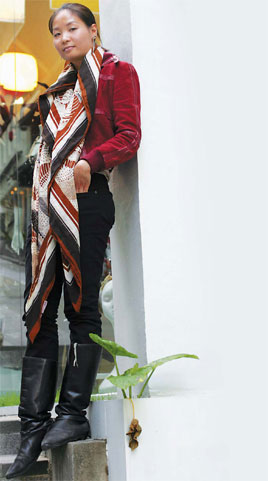 |
|
Designer Wu Laifan says she's had to rein in her ego to survive in the fashion industry. [Edmond Tang] |
Wu Laifan moved her fashion boutique in Hong Kong's Soho district from 67 Peel Street to 69 and changed its name from Fang Fong to Fang Fong Project last year. By moving a couple of meters down the street, the designer intended to transplant what she calls the "LA shopping experience" to this bars-and-boutiques area of Hong Kong.
The designer tore down the second floor to create a high ceiling and made room for giant windows that create light on the sales floor.
"This space is much more airy, bright and light-hearted," Wu says. "The idea is to make customers feel right at home."
As to the minimal decor, Wu believes her designs have "in-built" stories and thus there's no need to create an "artificial landscape" to tell them.
A sleeveless dress she designed recently features a boxy top with exaggerated shoulder lines, but morphs into a slim pencil skirt from the waist down.
"In the 70s and 80s, all the attention, in fashion terms, shifted to the shoulders. My designs give a nod to that era," she says. "As to the lower half, I've always loved the silhouette of a pencil skirt."
Despite the era referencing, this is not a nostalgic look at big shoulder-pad glamor, rather a fine execution in contrast.
Assertive as the designer is in her aesthetics, Wu admits the first thing she learned after graduating from design school at Hong Kong's Polytechnic University, was to rein in her imagination and her ego, in order to survive the reality of the industry. "I started working for a fashion company and the first collection I did for them was a fiasco," she says. "The cost of producing my designs was so high they were never made.
"You like what you like, but when it comes to designing for a brand that sells in shops, there's a tremendous amount of market research.
"A designer working in the real world works under various limitations, and you know your limitations by communicating with your targeted customers."
According to Kevin Ng, a fellow design graduate who worked for Esprit and Izzue, before setting up his own shop in nearby Elgin Street two years ago, a job with a big fashion company can be the launching pad for fledgling design careers.
"The good thing (about working for big brands) is they already have their own established image and market share. What you need to do is bring your ideas to the market you are working for," he says.
Another advantage, according to Ng, is for young designers to build up their contacts, from manufacturing to marketing.
But no amount of preparation can shield a young designer from the perils of the market place, Wu says, "no matter how talented you are".

Wu moved her first shop, inside a big mall at Tsim Sha Tsui, to 67 Peel Street, in 2005, increasing the floor space from 100 to 400 sq m, while the rent was eight times higher.
"It's true that places like Tsim Sha Tsui and Causeway have big customer flows. But the majority of them are either locals or tourists. They were not particularly fashionable people and didn't allow me much room to experiment," she says.
"Soho is different: The bulk of my customers are expatriates, ABC and BBC (American/British-born Chinese). These are fashion-forward people who have seen a lot and have a strong sense of personal style."
"I opened my first store in 2003 when Hong Kong was reeling from the SARS epidemic," she recalls. "A bad economy, like the one we are experiencing now, does affect business but good designs will always sell."
That being said, the designer concedes that the moderate size of her business means she has to follow the "major trends". "Before I sit down to draw, I take a look at what's happening on the runways of the world's fashion capitals - Paris, Milan, London and New York. You ignore those trends at your own expense."
As for Ng, reinterpreting current trends means "fashion architecture" - clothes that are constructed by pure sartorial engineering.
Ng's show at Hong Kong Fashion Week in July marked his return to fashion's center stage after a hiatus of 10 years. As a design student, he won the top prize of Young HK Fashion Designers' Competition during the city's fashion week in 1998.
"Fashion shows are not very effective at enhancing sales, but once you present your ideas on the runway, someone else might see them, get inspired and further develop those ideas into more mature forms. That's how the fashion industry grows," he says. "Eventually people will see where the idea originally came from."
More importantly, it helps the designer to strike a balance between the crazy and the commercial.
These days, Ng does his first samples upstairs on the second floor of the shop - a cramped space he shares with shoes and dresses from his latest runway show. "I do everything myself, including washing the toilet," he says.
Like Wu, Ng mainly uses stock fabrics - leftovers after orders from big fashion companies have been filled. The stock fabrics Wu has sought out during visits to the Chinese mainland have a vintage quality, featuring patterns with a strong Oriental feel. This has enabled the designer to fashion a cheongsam line that captures the area's mix of East and West, old and new.
Ng currently does two lines: One is called Wasabica and is built around the image of an Asian fight-girl; the other, more design-conscious and expensive, is cryptically titled SHHHH.
(China Daily January 14, 2009)